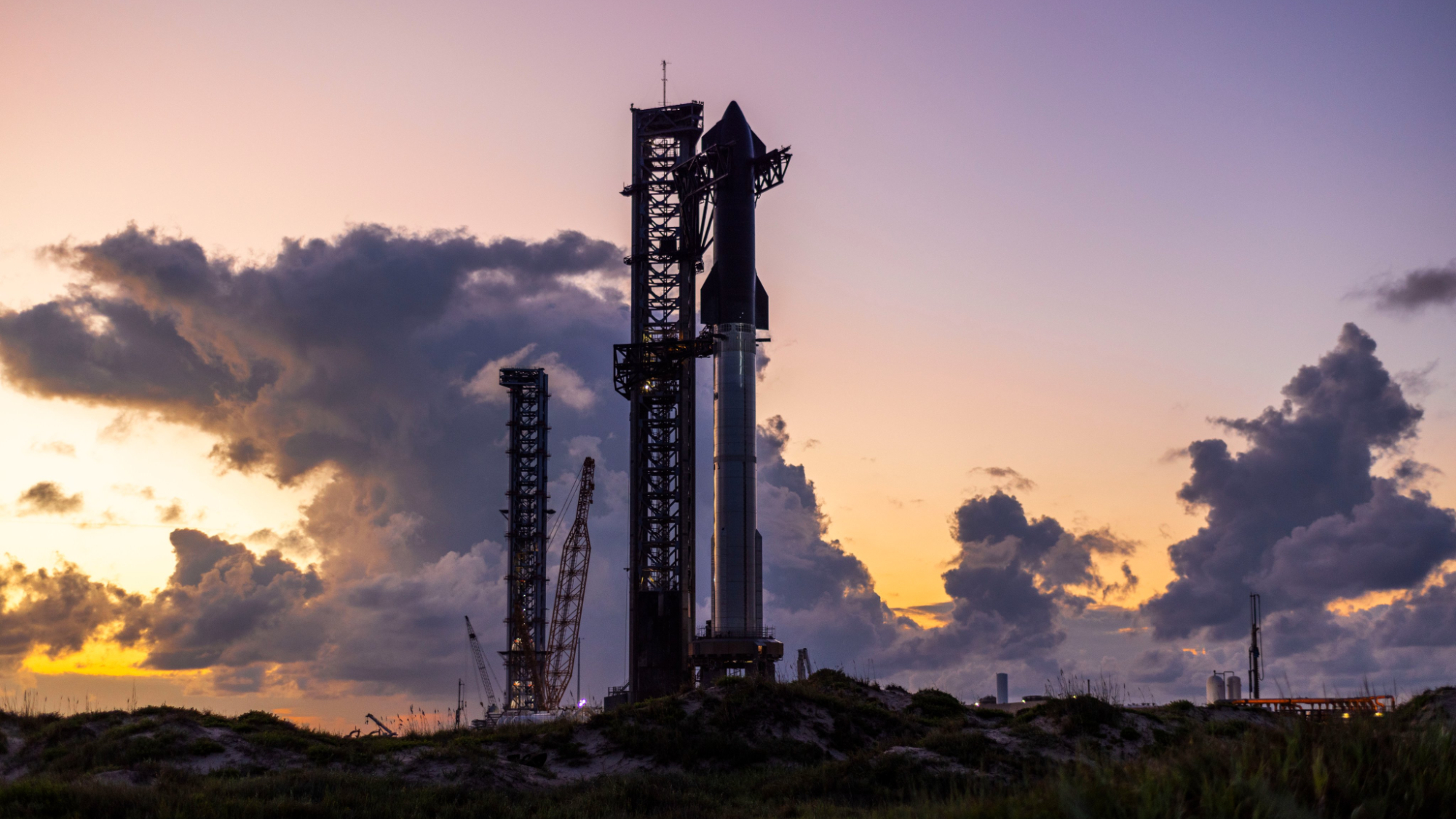SpaceX says its next Starship launch could fly as early as Oct. 13, pending FAA approval
SpaceX appears to be trying to force the FAA's hand.

SpaceX is preparing to launch the fifth flight of its Starship megarocket as soon as Oct. 13, despite repeated statements from the Federal Aviation Administration (FAA) that the flight test would likely have to wait until November.
Starship last flew in June, and SpaceX nailed its launch objectives by returning the rocket to Earth as well as soft landing both Starship and its Super Heavy first-stage booster at sea. Now, SpaceX wants to attempt the first-ever return of Super Heavy to the launch pad — complete with a mid-air booster catch conducted by the launch tower's "chopstick" arms.
"Starship's fifth flight test is preparing to launch as soon as October 13, pending regulatory approval," SpaceX wrote in a post on X, formerly Twitter, on Monday evening (Oct. 7). "Pending regulatory approval" is a big caveat here, considering the FAA's estimation that Starship's fifth integrated flight test (IFT-5) wouldn't be cleared "before late November 2024." However, this hasn't stopped SpaceX from barreling toward Starship's next flight as fast as it can.
During the lead-up to last night's Oct. 13 target date announcement, SpaceX had been busy completing prep work on the IFT-5 Starship. Operators had been attending to tasks such as stacking the vehicle, performing propellant load tests and other preflight checkouts over the last month.
Related: SpaceX's Elon Musk calls on FAA chief to resign
In light of the FAA's resistance to SpaceX's preferred timeline, the company has also been applying public pressure to the government agency. In a lengthy post on SpaceX's website, titled "Starships Are Meant to Fly," SpaceX claims the FAA's November timeline is "driven by superfluous environmental analysis," and disputes the FAA's assertion that SpaceX did not operate under the appropriate permits. "At no time did SpaceX operate the deflector without a permit," the update says, adding "[the Environmental Protection Agency] has agreed that nothing about the operation...needs to change."
NASA, too, is eager to see SpaceX complete the development of Starship, a vehicle the space agency has contracted to land astronauts on the moon as a part of the Artemis 3 mission, currently targeting 2026 for launch. And, as early as June 2023, officials at NASA began voicing concerns about Starship's availability come mission time. In order to receive NASA's stamp of approval, Starship has to meet extremely stringent qualification standards as well as complete several flights, which includes an uncrewed mission to the lunar surface, and back.
Get the Space.com Newsletter
Breaking space news, the latest updates on rocket launches, skywatching events and more!
Join our Space Forums to keep talking space on the latest missions, night sky and more! And if you have a news tip, correction or comment, let us know at: community@space.com.

Josh Dinner is the Staff Writer for Spaceflight at Space.com. He is a writer and photographer with a passion for science and space exploration, and has been working the space beat since 2016. Josh has covered the evolution of NASA's commercial spaceflight partnerships and crewed missions from the Space Coast, as well as NASA science missions and more. He also enjoys building 1:144-scale model rockets and human-flown spacecraft. Find some of Josh's launch photography on Instagram and his website, and follow him on X, where he mostly posts in haiku.
-
Unclear Engineer This is looking pretty bad for the decision process. Unless the FAA or EPA end up requiring some change in the SpaceX plans or facilities, this will just look like bureaucratic inability to get out of the way of development progress. And, if they insist on changes that are not perceived as realistically relevant, it will look political in the worst way - partisan political.Reply
As already reported by Space.com, Musk has publicly called for the resignation of the FAA administrator. And, now he has endorsed and started actively campaigning for the candidate for U.S. President who would most likely replace the FAA administrator.
This whole mess is going to hurt NASA's ability to get commercial support for U. S. space exploration and development goals. When NASA was the "owner" of a project, there was some partisan argument over its budget in Congress, but not in its regulation of actual process and hardware development.
NASA did the environmental changes to Merritt Island in Florida that SpaceX is doing to the same environmental type of area around Boca Chica, Texas. NASA's SLS is similar in power to the SuperHeavy. The real difference is reusability.
The U.S. Congress is no longer supporting the NASA budget sufficiently for NASA to return to the Moon on its own, much less support a continuous base there. Without the commercial interest in doing those things, the U.S. will not be going back to the Moon at all. But, China will get there, and Russia is now partnering with China. As will most other countries if the U.S. Artemis program stumbles and falls. -
Rob77 Yep - the whole SpaceX vs FAA is a big mess alright.Reply
Curious if Starship has the capabilities to launch its own moon missions without requiring services of NASA should the Artemis program tank?
Wondering how much NASA is involved with tracking & communication, even for current SpaceX / ISS missions? -
Unclear Engineer SpaceX is already contracted by NASA to develop a lander to take the Artemis astronauts from lunar orbit down to the lunar surface and back to the "gateway" lunar orbiter.Reply
So, SpaceX needs to develop Starship versions that will provide refueling in Earth orbit and probably also in lunar orbit. And SpaceX will need to develop the capability to get the lander(s?) and fuel to lunar orbit, because NASA is not working on that part, either.
So, it should not be a problem for SpaceX to put humans on the Moon, even without NASA being involved. The main component from NASA is the Orion capsule that can return from the Moon with direct reentry through the atmosphere, which creates a lot more heat to deal with than just reentering from low Earth orbit. But, it has already been done by the Apollo missions.
However, another approach would be to have the returning craft use rocket fuel for braking into low Earth orbit, and then take another vehicle down to the surface. That would make sense for a sustained lunar base scenario, where the idea is to make everything reusable to reduce costs. So, specialized craft to go between low Earth Orbit and lunar orbit does cost more fuel than coming in directly to atmospheric reentry, but probably costs less money, when you take into account the reusability and the fuel costs of putting throw-away spacecraft into space from Earth's surface.
As soon as I read that NASA had contracted with SpaceX to get the NASA astronauts onto the lunar surface from lunar orbit (and back again), I started wondering when it was going to become obvious that SLS could be replaced by StarShip + SuperHeavy.
